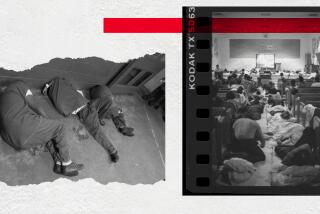Behave Like Anyone Else : Inmates Wouldn’t Flee in Quake, Researcher Finds
- Share via
If an earthquake were to shake down the walls of the most impenetrable prison, it’s only reasonable to assume that the inmates would gleefully escape, running loose to plunder, loot and terrorize.
Right?
Wrong, said a USC sociologist who has spent 15 years studying how humans cope with disaster.
“You could expect the inmates to act like anyone else trying to crawl out from under the debris,” Robert Stallings said.
Studies show that people with psychological problems hold up well during disasters, the associate professor at the USC School of Public Administration continued.
Stallings, the author of numerous articles on disaster-preparedness planning, including an analysis of prison management after earthquakes, said the great San Francisco quake of 1906 and the 1971 Sylmar quake that crushed parts of the walls of a juvenile detention facility prove that prisoners can be expected to behave calmly and rationally.
Most Inmates Return
Of the several dozen juvenile inmates who fled the Sylmar detention facility in the San Fernando Valley, only a handful didn’t come back, according to Stallings. The same was the case at several city jails in San Francisco.
Stallings conceded that, for obvious reasons, there haven’t been too many actual experiments testing inmate behavior during earthquakes.
But, Stallings maintains, “Inmates will show the same kind of camaraderie and behave like anyone else during those crisis hours,” adding that prisoners are human too and would have the same fears about their families or property as anyone else.
However, Stallings did acknowledge that several days following a disaster those prisoners who had not returned probably would not come back.
Rampage Exaggerated
Nonetheless, Stallings insists that the whole notion of prisoners overpowering guards and taking to the streets is overblown.
Although he doubts people would spend time worrying about California’s 38,000 prisoners during an emergency--concentrating instead on themselves--Stallings said the media, looking for new story angles, would likely drum up fears about rampaging inmates.
“These rumors that the walls have come down, that the guards have been overpowered and they’re out running around could cause people to arm themselves. There’d be a lot of trigger-happy people,” Stallings said.
Stallings said his purpose in discussing a potential scenario which he admits is not a pressing problem in many people’s minds is to encourage earthquake planners to consider how resources should be allocated during a crisis.
“Instead of diverting police and the California Highway Patrol to come and guard the prisoners, they could be better utilized elsewhere,” he said.
Stallings, who serves on the advisory board of the Southern California Earthquake-Preparedness Projects said, “If you treat these people like animals attempting to escape from their cages then maybe they’ll act like animals.”
More to Read
Sign up for Essential California
The most important California stories and recommendations in your inbox every morning.
You may occasionally receive promotional content from the Los Angeles Times.













